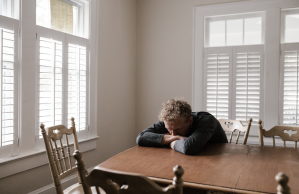Death and loss are experiences no one wants, and it’s never easy. It often leaves one different than they were before. Unfortunately, they are also universal experiences—everyone will live through some kind of loss during their life, whether that be due to death, job loss, divorce, or another source.
The words “grieving” and “mourning” are often used interchangeably when talking about loss, but in fact, there is a subtle difference between the two. Grief is more of a feeling (or group of feelings) that can occur before, during, and after loss, while mourning is the process of attempting to move through and adapt to grief.

What Is the Difference Between Grieving and Mourning?
When explaining the difference between mourning vs. grief, it helps to have a definition of the two.
Grief refers to the emotions, thoughts, and behaviors that a person experiences after a significant loss, such as the death of a loved one, the end of a relationship, or a major life change. Grief is a natural and normal response to loss, and it can involve feelings of sadness, anger, guilt, or numbness. It may also involve physical symptoms such as fatigue, difficulty sleeping, or changes in appetite.
Mourning, on the other hand, is an expression of grief that involves adapting to the loss and integrating it into one’s life. It is a more active process than grief and can involve a variety of rituals, customs, and behaviors that help individuals come to terms with their loss. Mourning might include activities such as funerals, memorial services, or personal rituals like creating a memory book or writing letters to the deceased.
In simpler terms, grief is a feeling that comes after loss, while mourning is a process that involves expressing and moving through grief—processing it and attempting to move past it.
What Is the Difference Between Mourning and Sorrow?
Mourning and sorrow are both emotional responses to loss or grief, but they have distinct differences, similarly to mourning and grief.
As previously stated, mourning typically refers to the external expressions of grief, such as ceremonies, rituals, or public displays of sadness. It can also involve specific actions, such as wearing black clothing or observing a period of silence. Mourning is often a culturally defined process, and the practices it observes vary depending on the society, religion, or community in which it takes place.
Sorrow is an internal emotional state characterized by feelings of sadness, powerlessness, and loss as well as grief. It’s often expressed through tears, solitude, or withdrawal from activities. Sorrow, much like grief, is a natural response to loss, and it can occur for a variety of reasons, such as the loss of a loved one, the end of a relationship, or the loss of a job.
What Is an Example of Mourning?
During mourning, people may take part in certain activities or rituals to help them cope with loss, such as attending a funeral or memorial service, creating a memorial for the deceased, or seeking support from family members, friends, or a grief counselor.
Mourning is a personal and individual process, and the way in which people express their grief can vary widely depending on their culture, personal beliefs, and relationship with the person who has passed away. Because of this, the mourning process can look wildly different around the world, even though it is centered around the same experience of loss.
What Is an Example of Grieving?
Grieving is a natural and normal response to a significant change, and it can manifest itself in different ways for different people. Some examples of reasons people experience grief might include:
- The death of a loved one. People often experience feelings of sadness, shock, denial, or guilt as well as physical symptoms such as loss of appetite, difficulty sleeping, and fatigue.
- A breakup or divorce. This may involve similar feelings to grief after a death such as sadness and shock, but also include feelings of rejection, betrayal, loneliness, and uncertainty about the future.
- The loss of a job or major life change. This type of loss may cause feelings of anxiety, uncertainty, rejection, and a sense of loss of identity.
- A major failure of disappointment. Feelings of frustration, self-doubt, or even a loss of motivation are common after events like experiencing failure.
Grief can be extremely painful and hard to deal with, so finding support in community and connection can be helpful for people. Therapy can also provide support and guidance for people as they grieve. If you’re having a hard time dealing with grief and loss, consider finding a grief and loss therapist to help you process your feelings and give you the support and assistance you need.
Hello, we're here to help you
We provide award-winning mental health services nationwide, with flexible scheduling & insurance coverage. Start your journey this week.
What Are the Stages of Mourning?
Though there aren’t any official stages of “mourning,” many people experiencing mourning or grief find the framework commonly referred to as the “5 Stages of Grief” helpful as they process loss.
The stages of grief make up a framework that describes the emotional and psychological journey people go through after experiencing a significant loss, such as the death of a loved one, a divorce, or another type of loss. While everyone’s experience of grief is unique, these stages are commonly used to help people understand and process their emotions:
- Denial: In this stage, a person may struggle to believe that the loss has actually occurred. They may feel numb or in shock, and may have difficulty accepting the reality of the situation.
- Anger: As the reality of the loss sets in, a person may experience intense feelings of anger and frustration. They may feel like they have been unfairly treated or that someone or something is to blame for their loss.
- Bargaining: In this stage, a person may try to negotiate with a higher power or with themselves in an attempt to change the outcome of the situation. They may make promises or ask for second chances.
- Depression: As they begin to feel the intensity of the grief, a person may start to feel overwhelmed and hopeless. They may experience a sense of deep sadness and may withdraw from others.
- Acceptance: In the final stage of mourning, a person begins to come to terms with their loss and find a way to move forward. They may feel a sense of peace or closure, and may start to make plans for the future without their loved one.
It’s important to remember that not everyone experiences these stages in the same order, and some people may not experience all of them. Grief is a complex, individual, and non-linear process, and it’s important to remember that everyone needs to experience it in their own way.
Grief and mourning happen alongside each other, and can feel overwhelming. Getting help from a mental health professional is a great option for people who need help sorting out their emotions, moving through them, and learning how to live in their new reality. They are equipped to deal with the deep and painful emotions you’re experiencing, and can help you overcome them.












